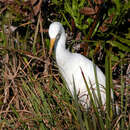Brief Summary
provided by EOL authors
The Cattle Egret (Bubulcus ibis) is an Old World species that colonized northeastern South America from Africa in the 1870s and 1880s (although it may not have actually established until decades later), spread to Florida by the 1940s or 1950s, and reached California by the mid-1960s. More recently, it has colonized the Australasian region. In the Western Hemisphere, the Cattle Egret breeds locally from most of the United States (and adjacent Canada) south (mainly in coastal lowlands) through Middle America, the West Indies, and South America (including Trinidad and Tobago and the Galapagos Islands) to northern Chile and northern Argentina; in southern Europe, it breeds from the Mediterranean region east to the Caspian Sea and south throughout most of Africa (except the Sahara), including Madagascar and islands in the Indian Ocean. In Southeast Asia, it breeds from India east to eastern China, Japan, and the Ryukyu Islands and south throughout the Philippines and East Indies to New Guinea and Australia. In the New World, Cattle Egrets winter throughout much of the breeding range from the West Coast, Gulf Coast, and Florida in the United States south through the West Indies, Middle America, and South America. In the Old World, they winter from southern Spain and northern Africa south and east through the remainder of the breeding range in Africa and southwestern Asia and from southern Asia and the Philippines south through Indonesia and the Australian region. The Cattle Egret was introduced to the Hawaiian Islands in 1959 and is now established on most of the larger Hawaiian Islands. The Cattle Egrets in Asia and Australia are sometimes treated as a distinct species, the Eastern Cattle Egret (B. coromanda), separate from the Western Cattle Egret (Bubulcus ibis). Unlike other herons and egrets, this species typically feeds in dry fields, often following cattle or other grazing animals and waiting for them to flush insects. It also occurs in other open habitats, including aquatic ones. It nests in low trees and shrubs in mixed colonies with other species of herons and egrets. When associated with grazing cattle in fields, Cattle Egrets feed mainly on large insects flushed by the cattle, but in other situations they may eat crayfish, earthworms, snakes, nestling birds, bird eggs, and sometimes fish. They may also scavenge for food in garbage dumps. Although often associated with cattle or horses in North America, on other continents Cattle Egrets may follow elephants, camels, zebras, deer, and other grazers. They may also follow tractors and lawnmowers. Cattle Egrets usually first breed at 2 to 3 years of age. The male establishes a pairing territory in or near the colony and displays there to attract a mate. Displays include stretching the neck and raising plumes while swaying from side to side, making short flights with exaggerated deep wingbeats. The nest site is typically in a tree or shrub in a heron rookery on an island or in a swamp. The nest is built mainly by the female using materials collected mainly by the male. It is a platform or shallow bowl of sticks, often with green, leafy twigs added. The typically 3 to 4 (range 1 to 9) eggs are pale blue. Incubation is by both sexes for 21 to 26 days. Young are fed by both parents (by regurgitation). The young begin to climb around near the nest at around 15 to 20 days, to fly at 25 to 30 days, and become independent around 45 days. Cattle Egrets are strongly migratory. Birds from northern breeding areas in North America may winter to the West Indies, Middle America, and northern South America. In the United States, they are common year-round in Florida, along the Gulf Coast, and in parts of the Southwest. Young birds may disperse great distances, even thousands of kilometers. (Crosby 1972; Maddock and Geering 1994; Kaufman 1996; AOU 1998; Dunn and Alderfer 2011)

